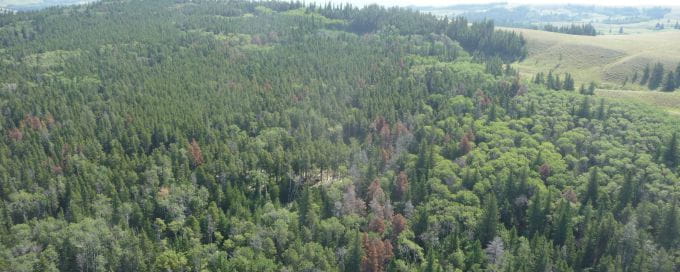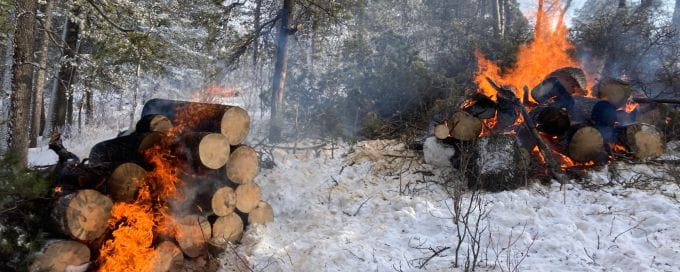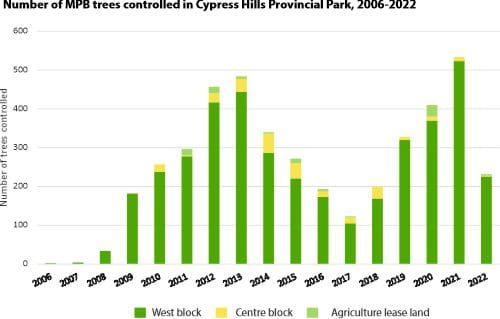
Why we measure this
The mountain pine beetle (MPB), or Dendroctonus ponderosae, is a small bark beetle about 4.0 to 7.5 mm in length – approximately the size of a grain of rice. MPB is the most significant pest threat to pine forests in North America. It can colonize and kill jack pine trees, posing a threat to pine forest ecosystems and sustainable development of the forest industry in Saskatchewan and across Canada.
Saskatchewan serves as a critical barrier to stopping the spread of mountain pine beetles in Canada’s Boreal forest. If MPB spreads across Saskatchewan, the rate of spread will likely increase substantially because the distribution and density of pine forests increases in eastern forests. Confirming MPB (presence or absence) in the northern boreal is a significant measure, helping to guide the Ministry of Environment's risk assessment policies and subsequent response actions.
The MPB outbreak in British Columbia infested more than 18 million hectares and killed 731 million cubic metres, or 54 per cent, of the province's merchantable lodgepole pine. Those losses impacted forest-dependent communities.
Forestry is the largest industry in Saskatchewan's north. The forest industry depends on a sustainable supply of forest products. On average, one-third to one-half of all softwood manufactured in Saskatchewan annually is jack pine. In 2022, Saskatchewan's forestry industry supported nearly 8,000 direct and indirect jobs and generated more than $1.7 billion in forest product sales, of which more than 60 per cent is from exports. Losses of pine inventory would interrupt the long-term sustainable wood supply to mills, resulting in reduced mill productivity, manufacturing and ultimately job loss.
Many of Saskatchewan's most visited provincial parks (Cypress Hills, Meadow Lake, La Ronge, Narrow Hills, Candle Lake and Makwa Lake) have large pine forests that, if killed by the beetle, would have serious implications on visitation, experience and public safety.
The beetle has been designated under The Forest Resources Management Act, which makes it illegal to import, transport and store pine logs and pine forest products with bark attached if they originate from British Columbia, Alberta, an area in southwestern Saskatchewan around Cypress Hills Interprovincial Park and the United States.
What is happening

Since crossing the Rocky Mountains in two mass dispersal events in 2006 and 2009, MPB has spread into lodgepole pine and jack pine forest ecosystems in central and eastern Alberta. Monitoring and early detection of the presence and severity of insect and disease in the forest helps ensure timely detection and response.
Currently, no mountain pine beetles have been detected in the boreal monitoring area.
The overall trend is improving, as the risk of eastern spread through Alberta has declined. Since reaching a peak in 2019, populations in Alberta collapsed by 94 per cent in 2022. The decline can be attributed to sustained early and aggressive control efforts and climatic events that created unfavourable conditions for beetle development and survival. Extreme cold winters in 2019, 2020 and 2021, as well as a cool wet summer in 2019, slowed population growth. Large populations that had been building in the Jasper and Hinton areas of western Alberta have now collapsed. The threat that MPB will spread east through central Alberta and into Saskatchewan's northwest boreal forest has declined. However, MPB populations can increase as quickly as they decrease, and the threat may return in the future if we experience climatically suitable conditions.

What we are doing
In Saskatchewan, MPB surveillance is conducted in the boreal northwest and in Cypress Hills Interprovincial Park. The ministry conducts ground-based monitoring in highly susceptible jack pine forests in the northwest boreal forest. Between 2011 and 2017, the ministry established a network of helicopter landing and tree-baiting sites to improve access and capacity to detect the leading edge of MPB infestation in the boreal forest. Trees, baited with MPB attractant chemicals, are established in 57 areas where highly susceptible pine exists throughout northwest Saskatchewan. Fifty sites are located north and south of the Cold Lake Air Weapons Range, and seven sites are located within the Air Weapons Range.
Survey and monitoring data support a framework that is crucial to the integrity of a long-term forest health management plan for Saskatchewan. The measure for MPB in the boreal forest is currently its presence or absence. Currently, no mountain pine beetles have been detected in the boreal monitoring area.
The MPB is a natural component of the lodgepole pine forest ecosystem in Cypress Hills Interprovincial Park and is being actively managed through aerial and ground surveys. All lodgepole pine stands within Cypress Hills Interprovincial Park (Centre Block and West Block) and adjacent forested agricultural leased lands around the park (excluding Alberta) are surveyed. If beetles are found, surveyors expand their search area in a circle around infested trees to locate all the trees attacked in the current year.
Once infested trees are found and marked, the next step is a quick and aggressive control response. The most effective control method is to find the beetle-infested trees in fall and winter months, cut them down and burn them before the beetles can leave and attack healthy pine trees in the late spring or early summer. MPB-infested trees are controlled within Cypress Hills Interprovincial Park by the Ministry of Parks, Culture and Sport.





